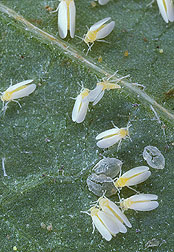This page has been archived and is being provided for reference purposes only. The page is no longer being updated, and therefore, links on the page may be invalid.
Read the magazine story to find out more. |
|
|
Possible New Control for Whiteflies Discovered
By Alfredo FloresMay 11, 2007
An unusually durable fungus that was first spotted on tiny insects feeding on eggplants in Texas may become a new biological control for the widespread and costly agricultural pests known as whiteflies.
The fungus was first isolated by Agricultural Research Service (ARS) entomologist Enrique Cabanillas, working with entomologist Walker Jones at the ARS Beneficial Insects Research Unit, Weslaco, Texas.
The silverleaf whitefly, Bemisia argentifolii (previously known as B. tabaci biotype B), may be small in stature, but it can be deadly as a pest—sucking and feeding on the juices of a myriad of host plants. Heavy feeding can give plants under attack a yellow, mottled look and eventually kill them. Whiteflies cause major crop losses, both directly by feeding and indirectly by transmitting plant viruses.
Pesticides have been ineffective for controlling whiteflies because of a built-in natural resistance, the need for repeated applications and the potential hazard some insecticides may pose to the environment, animal life or humans.
Isolated by Cabanillas in 2001, the new fungal species has been named Isaria propawskii. In the Lower Rio Grande Valley of Texas, it has been shown to kill both larval and adult stages of silverleaf whitefly. In fact, since 2001, it has periodically wiped out whiteflies at the ARS insect-rearing facilities in Weslaco.
Notable aspects of I. propawskii include its natural establishment in a semiarid region where temperatures can reach 107 degrees Fahrenheit—and its continuing persistence, even in the absence of insect hosts. A high spore production in common culture media makes this fungus comparatively easy to grow in vitro, in the laboratory.
These features, plus its high pathogenic potential against a second major insect pest—the glassy-winged sharpshooter, Homalodisca vitripennis (previously known as H. coagulata)—make the I. propawskii fungus a promising candidate for practical biological control of two major U.S. farm pests.
Read more about this research in the May/June 2007 issue of Agricultural Research magazine.
ARS is the U.S. Department of Agriculture's chief scientific research agency.

